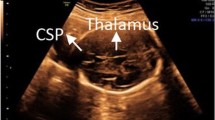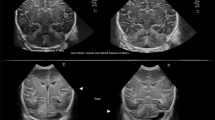Abstract
Posterior fossa (PF) malformations are commonly observed during prenatal screening. Their understanding requires knowledge of the main steps of PF development and knowledge of normal patterns in US and MR imaging. The vast majority of PF malformations can be strongly suspected by acquiring a midline sagittal slice and a transverse slice and by systematically scrutinizing the elements of the PF: cerebellar vermis, hemispheres, brainstem, fourth ventricle, PF fluid spaces and tentorium. Analysis of cerebellar echogenicity and biometry is also useful. This review explains how to approach the diagnosis of the main PF malformations by performing these two slices and answering six key questions about the elements of the PF. The main imaging characteristics of PF malformations are also reviewed.










Similar content being viewed by others
References
Jaspan T (2008) New concepts on posterior fossa malformations. Pediatr Radiol 38(Suppl 3):S409–S414
Sidman RL (1982) Histology and histopathology of the nervous system In: Haymaker W, Adams RD (eds) Development of the human central nervous system. Thomas CC, Springfield, IL pp 94–110
ten Donkelaar HJ, Lammens M (2009) Development of the human cerebellum and its disorders. Clin Perinatol 36:513–530
ten Donkelaar HJ, Lammens M, Wesseling P et al (2003) Development and developmental disorders of the human cerebellum. J Neurol 250:1025–1036
Babcook CJ, Chong BW, Salamat MS et al (1996) Sonographic anatomy of the developing cerebellum: normal embryology can resemble pathology. AJR 166:427–433
Limperopoulos C, Robertson RL, Estroff JA et al (2006) Diagnosis of inferior vermian hypoplasia by fetal magnetic resonance imaging: potential pitfalls and neurodevelopmental outcome. Am J Obstet Gynecol 194:1070–1076
Nelson MD Jr, Maher K, Gilles FH (2004) A different approach to cysts of the posterior fossa. Pediatr Radiol 34:720–732
Robinson AJ, Blaser S, Toi A et al (2007) The fetal cerebellar vermis: assessment for abnormal development by ultrasonography and magnetic resonance imaging. Ultrasound Q 23:211–223
Zalel Y, Seidman DS, Brand N et al (2002) The development of the fetal vermis: an in-utero sonographic evaluation. Ultrasound Obstet Gynecol 19:136–139
Zalel Y, Yagel S, Achiron R et al (2009) Three-dimensional ultrasonography of the fetal vermis at 18 to 26 weeks’ gestation: time of appearance of the primary fissure. J Ultrasound Med 28:1–8
Malinger G, Lev D, Lerman-Sagie T (2009) The fetal cerebellum. Pitfalls in diagnosis and management. Prenat Diagn 29:372–380
Malinger G, Ginath S, Lerman-Sagie T et al (2001) The fetal cerebellar vermis: normal development as shown by transvaginal ultrasound. Prenat Diagn 21:687–692
Parazzini C, Righini A, Rustico M et al (2008) Prenatal magnetic resonance imaging: brain normal linear biometric values below 24 gestational weeks. Neuroradiology 50:877–883
Tilea B, Alberti C, Adamsbaum C et al (2009) Cerebral biometry in fetal magnetic resonance imaging: new reference data. Ultrasound Obstet Gynecol 33:173–181
Adamsbaum C, Moutard ML, Andre C et al (2005) MRI of the fetal posterior fossa. Pediatr Radiol 35:124–140
Guibaud L (2004) Practical approach to prenatal posterior fossa abnormalities using MRI. Pediatr Radiol 34:700–711
Guibaud L, des Portes V (2006) Plea for an anatomical approach to abnormalities of the posterior fossa in prenatal diagnosis. Ultrasound Obstet Gynecol 27:477–481
Alkan O, Kizilkilic O, Yildirim T (2009) Malformations of the midbrain and hindbrain: a retrospective study and review of the literature. Cerebellum 8:355–365
Stroustrup Smith A, Levine D, Barnes PD et al (2005) Magnetic resonance imaging of the kinked fetal brain stem: a sign of severe dysgenesis. J Ultrasound Med 24:1697–1709
Zalel Y, Gilboa Y, Gabis L et al (2006) Rotation of the vermis as a cause of enlarged cisterna magna on prenatal imaging. Ultrasound Obstet Gynecol 27:490–493
Limperopoulos C, Robertson RL Jr, Khwaja OS et al (2008) How accurately does current fetal imaging identify posterior fossa anomalies? AJR 190:1637–1643
Fluss J, Blaser S, Chitayat D et al (2006) Molar tooth sign in fetal brain magnetic resonance imaging leading to the prenatal diagnosis of Joubert syndrome and related disorders. J Child Neurol 21:320–324
McAuliffe F, Chitayat D, Halliday W et al (2008) Rhombencephalosynapsis: prenatal imaging and autopsy findings. Ultrasound Obstet Gynecol 31:542–548
Demaerel P (2002) Abnormalities of cerebellar foliation and fissuration: classification, neurogenetics and clinicoradiological correlations. Neuroradiology 44:639–646
Guibaud L, Garel C, Annie B et al (2003) Prenatal diagnosis of capillary telangiectasia of the cerebellum—ultrasound and MRI features. Prenat Diagn 23:791–796
Merzoug V, Flunker S, Drissi C et al (2008) Dural sinus malformation (DSM) in fetuses. Diagnostic value of prenatal MRI and follow-up. Eur Radiol 18:692–699
Cameron M, Moran P (2009) Prenatal screening and diagnosis of neural tube defects. Prenat Diagn 29:402–411
Author information
Authors and Affiliations
Corresponding author
Rights and permissions
About this article
Cite this article
Garel, C. Posterior fossa malformations: main features and limits in prenatal diagnosis. Pediatr Radiol 40, 1038–1045 (2010). https://doi.org/10.1007/s00247-010-1617-7
Received:
Accepted:
Published:
Issue Date:
DOI: https://doi.org/10.1007/s00247-010-1617-7




